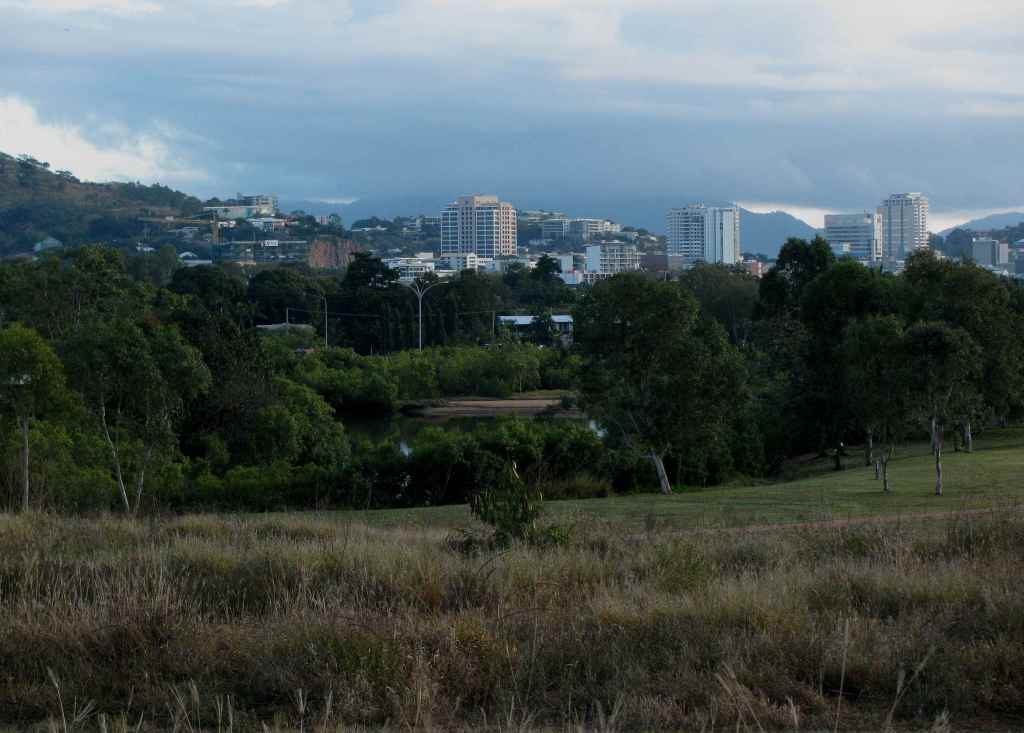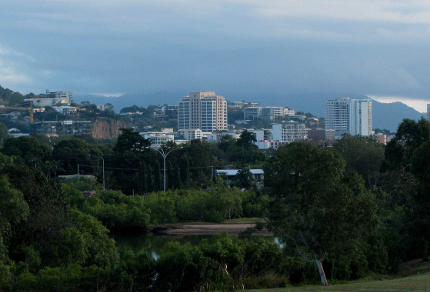
Townsville (© Magi Nams)
In the new light of 5:20 a.m., I strode toward the Sunrise Shopping Centre and its red metal Australia Post box to mail a pair of letters to Canada. Milky-blue, cumulus clouds billowed high to the southwest of Townsville, while a pink smear of incipient sunrise streaked the eastern sky. To the northwest, stacks of dense, grey cloud stood piled over the coast. The early morning was thick with warmth and thin with traffic. White-breasted woodswallows twittered and soared above Bowen Road, while a flock of rock doves spattered the sky with dark grey before landing on the Coles store roof. The rough screams of a sulphur-crested cockatoo tore the air, which moved in close on me – hot, thick, too sticky, with the odd fleck of drizzle fallen from brooding clouds touching my skin and promising more downpours. Cloying scents of mangoes and blooming trees and shrubs hung in the air, and water lay still in cement canals, inviting mosquitoes and fevers – dengue, Ross River. I posted my letters and retraced my steps, the drizzle at first more insistent, and then transforming into full-fledged rain by the time I reached Lindsay Street. Shielding my glasses with my hand, I jogged home, traded sneakers for crocs, opened an umbrella over my head, and walked in the warm tropical rain.
Twelve hours later, as Vilis and I drove toward Thuringowa, a black wall of cloud loomed over the southern city suburb and obliterated Mount Stuart. At odds with the ominous sky conditions, families – many with babies or toddlers in strollers – lined Thuringowa Drive on the stretch between Willows Shopping Centre and the central library on Hinchinbrook Drive. On our arrival at the library, where Vilis was scheduled to present a talk for the JCU ‘Live at the Library’ series, we learned that the crowd had gathered for the Santa Parade, which appeared to be in imminent danger of being washed away by torrential rain.
While Vilis made final preparations for his talk, rain that at first drummed lightly on the library roof became a roaring deluge that drowned out the sounds of a military band participating in the parade. Lightning repeatedly split the blackness beyond the library windows, and we could only assume the crowd awaiting the parade had run for shelter. A dozen bedraggled adults and children slowly trickled into the library to hear Vilis speak, his presentation at first almost overpowered by the violence of the storm. However, as the rain and thunder abated, the audience became became immersed in a scientific tale explaining the 10-year population cycle of lynx and snowshoe hares in Canada’s continent-spanning boreal forest; in particular the boreal forest of the Shakwak Valley northwest of Whitehorse in the Yukon Territory.
The audience chuckled when Vilis showed a graph comparing Townsville’s annual maximum and minimum temperatures with those of Whitehorse, the two sets of temperature data on the same graph showing the Yukon Territorial capital’s summer maximimum temperatures rising to a few degrees below Townsville’s winter maximums. The sight of snow – and lots of it – in photographs was perhaps as exotic to the audience (although we later learned that one audience member was a transplanted Calgarian) as the sight of palm trees was to Vilis and me on our arrival in Townsville.
And then, there were the northern mammals – snowshoe hares, lynxes, coyotes, red squirrels, the hares and coyotes bearing a resemblance to Australia’s introduced rabbits and dingoes, but the lynxes and squirrels totally unlike any Australian mammal. The photo of grizzly bear paw prints on a door elicited a nervous ripple of exclamations, as did Vilis’s anecdote about a grizzly becoming trapped inside an electric fence and chasing a field assistant up a tree. The photos of electrified fences enclosing square-kilometre plots of forest to exclude snowshoe hare predators from their prey, and those of nets and spans of monofilament strung between spruce trees to deter aerial predators from attacking hares, fascinated the audience.
These photos, of course, were accompanied by Vilis’s explanations of how the multi-university research project he worked for was conducting experiments to determine the cause of the 10-year cycle of snowshoe hares (with lynx numbers tracking these cycles, since lynx feed nearly exclusively on hares). Two hypotheses had previously been put forward – one that the hares’ food supplies dictated their changing numbers, and the other than the determining factor was predation on the hares. Thus, to test these hypotheses and a hypothesis that incorporated both food and predation factors, the researchers created four experimental conditions. They added extra food in the form of Purina Rabbit Chow pellets to several experimental plots, one of which was enclosed within an electric fence to exclude predators. That created two experimental conditions, one of simply adding food, and one of adding food and protecting hares. A second electric fence also excluded predators, but the kilometre-square experimental plot within it received no added hare food. Still other experimental plots acted as controls and remained as they had been, with no fence and no extra food.
The live-trapping and counting of hares within these different experimental sites eventually yielded data showing that neither added food nor predator-exclusion on its own controlled the hare population numbers, but rather a combination of the two seemed to do the trick. Of course, Vilis explained this in a much more entertaining manner than this, one that included a description of how to measure the hind foot of a snowshoe hare, which when coupled with body weight, is a good indicator of overall bunny health, as well as another explanation as to why old fishing nets are not good materials to use to exclude aerial predators since they sag when covered with snow and necessitate crawling around under them in the snow to count hares caught in live-traps. And so on.
However, Vilis’s tour de force came when, at the end of his presentation (which had included snippets about northern Canada lifestyle) he described the difficulties inherent in using longdrops (outhouses) in a climate where solid wastes freeze and form ever-growing towers that eventually (this story went on for a long time and elicited much laughter) necessitate the moving of the outhouse or desertion of the skittish research troops. After the talk ended, one audience member suggested lifting off the longdrop, throwing some diesel onto the tower, and burning it. Another seconded the suggestion, again from personal experience. So, a technique employed here in Oz to deal with longdrop stench in a hot climate could be the answer to the outhouse woes of research field crews working in Canada’s North.


